warning TOYOTA PRIUS PLUG-IN HYBRID 2015 1.G Quick Reference Guide
[x] Cancel search | Manufacturer: TOYOTA, Model Year: 2015, Model line: PRIUS PLUG-IN HYBRID, Model: TOYOTA PRIUS PLUG-IN HYBRID 2015 1.GPages: 21, PDF Size: 1.68 MB
Page 2 of 21
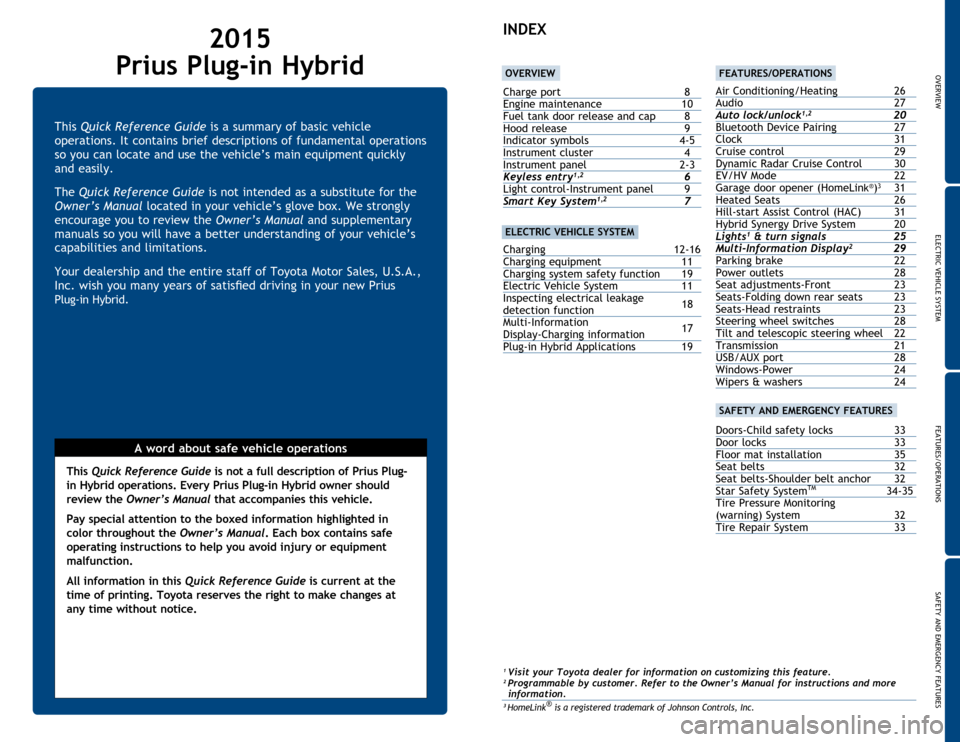
1
This Quick Reference Guide is a summary of basic vehicle
operations. It contains brief descriptions of fundamental operations
so you can locate and use the vehicle’s main equipment quickly
and easily.
The Quick Reference Guide is not intended as a substitute for the
Owner’s Manual located in your vehicle’s glove box. We strongly
encourage you to review the Owner’s Manual and supplementary
manuals so you will have a better understanding of your vehicle’s
capabilities and limitations.
Your dealership and the entire staff of Toyota Motor Sales, U.S.A.,
Inc. wish you many years of satisfied driving in your new Prius
Plug-in Hybrid
.
A word about safe vehicle operations
This Quick Reference Guide is not a full description of Prius Plug-
in Hybrid operations. Every Prius Plug-in Hybrid owner should
review the Owner’s Manual that accompanies this vehicle.
Pay special attention to the boxed
information highlighted in
color throughout the Owner’s Manual. Each box contains safe
operating instructions to help you avoid injury or equipment
malfunction.
All information in this Quick Reference Guide is current at the
time of printing. Toyota reserves the right to make changes at
any time without notice.
2015
Prius Plug-in Hybrid
INDEX
1 Visit your Toyota dealer for information on customizing this feature.2 Programmable by customer. Refer to the Owner’s Manual for instructions and more
information.
3 HomeLink® is a registered trademark of Johnson Controls, Inc.
OVERVIEWFEATURES/OPERATIONS
Air Conditioning/Heating 26
Audio 27
Auto lock/unlock
1,2 20
Bluetooth
Device Pairing 27
Clock
31
Cruise control
29
Dynamic
Radar Cruise Control
30
EV/HV
Mode
22
Garage
door opener (HomeLin
k®)3 31
Heated
Seats
26
Hill-start Assist Control (HAC) 31Hybrid Synergy Drive System 20
Lights1 & turn signals 25
Multi-Information Display2 29
Parking
brake
22
Power outlets
28
Seat
adjustments-Front
23
Seats-Folding
down rear seats
23
Seats-Head
restraints
23
Steering
wheel switches
28
Tilt and
telescopic steering wheel
22
Transmission
21
USB/AUX port
28
Windows-Power
24
Wipers & washers
24
Doors-Child safety locks 33
Door locks 33
Floor
mat installation
35
Seat
belts
32
Seat
belts-Shoulder belt anchor
32
Star
Safety System
TM 34-35
Tire Pressure Monitoring
(warning)
System
32
Tire Rep
air System
33
Charge port 8
Engine maintenance 10
Fuel tank door release and cap
8
Hood release
9
Indicator symbols
4-5
Instrument cluster
4
Instrument panel
2-3Keyless entry1,2 6
Light control-Instrument panel 9
Smart Key System1,2 7
Charging 12-16
Charging equipment 11
Charging system safety function
19
Electric Vehicle System
11
Inspecting electrical leakage
detection function
Multi-Information
Display-Charging information
Plug-in Hybrid Applications
19
17 18
ELECTRIC VEHICLE SYSTEM
SAFETY AND EMERGENCY FEATURES
OVERVIEWELECTRIC VEHICLE SYSTEM FEATURES/OPERATIONS
SAFETY AND EMERGENCY FEATURES
Page 4 of 21
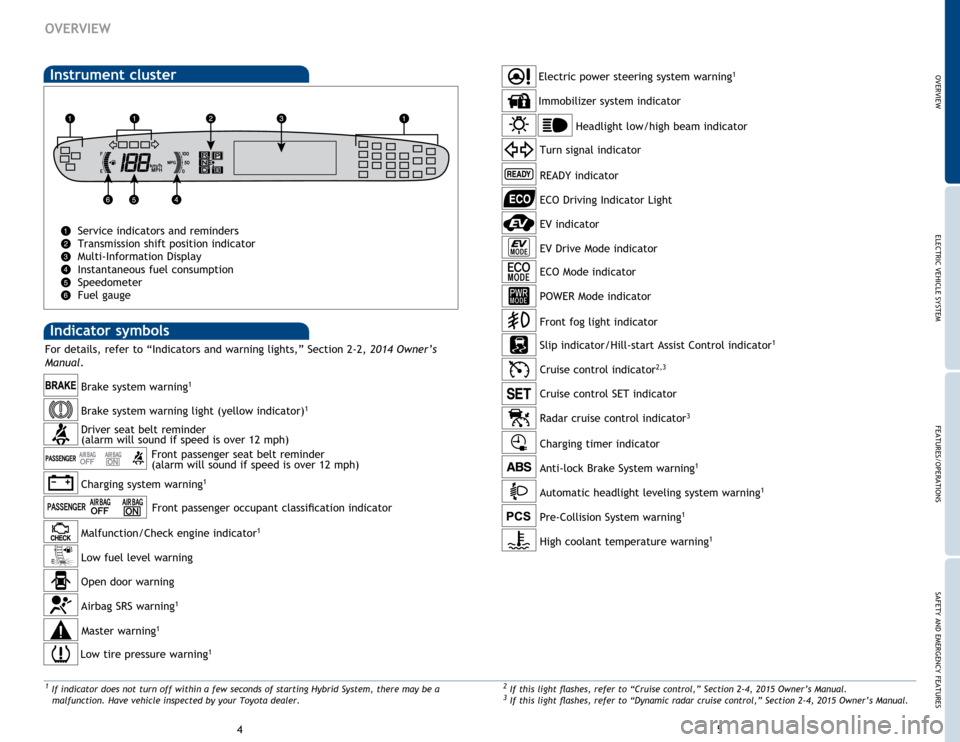
5
4
OVERVIEW
Indicator symbols
Instrument cluster
Service indicators and reminders
Transmission shift position indicator
Multi-Information Display
Instantaneous fuel consumption
Speedometer
Fuel gauge
Charging system warning1
Brake system warning1
Front passenger occupant classification indicator
2 If this light flashes, refer to “Cruise control,” Section 2-4, 2015 Owner’s Manual.3 If this light flashes, refer to “Dynamic radar cruise control,” Section 2-4, 2015 Owner’s Manual.
Anti-lock Brake System warning1
Headlight low/high beam indicator
Turn signal indicator
Slip indicator/Hill-start Assist Control indicator
1
Cruise control indicator2,3
Cruise control SET indicator
Radar cruise control indicator
3
Low tire pressure warning1
Immobilizer system indicator
Open door warning
Airbag SRS warning1
Master warning1
Driver seat belt reminder
(alarm will sound if speed is over 12 mph) Front passenger seat belt reminder
(alarm will sound if speed is over 12 mph)
Malfunction/Check engine indicator
1
Low fuel level warning
Electric power steering system warning1
READY indicator
Front fog light indicator
Brake system warning light (yellow indicator)1
ECO Mode indicator
EV Drive Mode indicator
Automatic headlight leveling system warning
1
1 If indicator does not turn off within a few seconds of starting Hybrid System, there may be a
malfunction.
Have vehicle inspected by your Toyota dealer.
For details, refer to “Indicators and warning lights,” Section 2-2, 2014 Owner’s
Manual .
Charging timer indicator
Pre-Collision System warning1
High coolant temperature warning1
POWER Mode indicator
ECO Driving Indicator Light
EV indicator
OVERVIEWELECTRIC VEHICLE SYSTEM FEATURES/OPERATIONS
SAFETY AND EMERGENCY FEATURES
Page 7 of 21
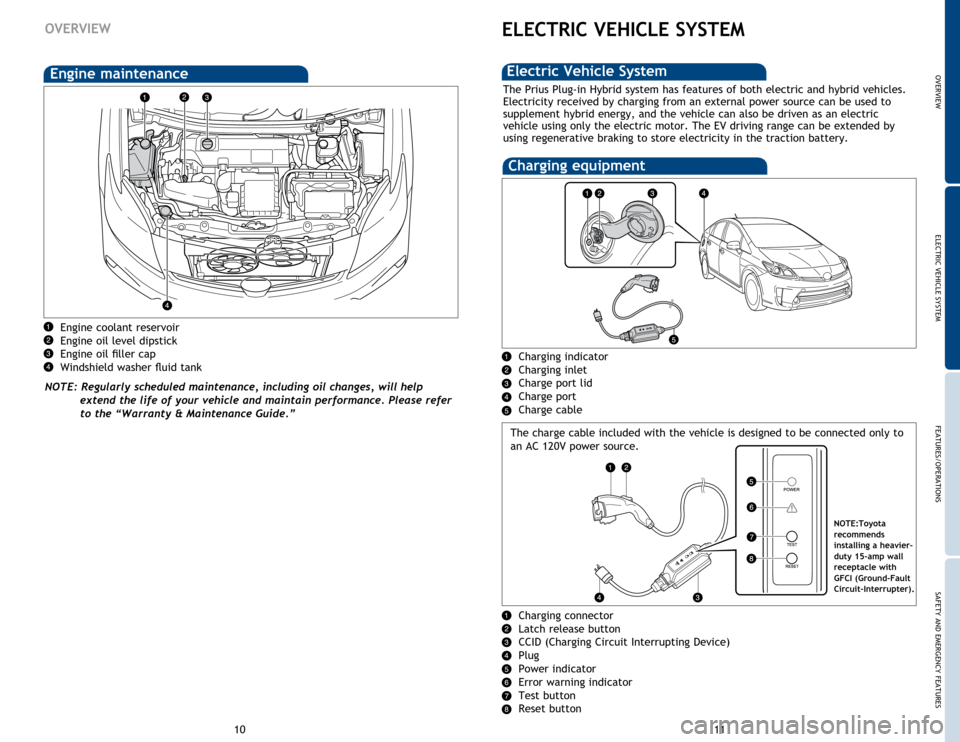
11
10
Engine coolant reservoir
Engine oil level dipstick
Engine oil filler cap
Windshield washer fluid tank
NOTE: Regularly scheduled maintenance, including oil changes, will help extend the life of your vehicle and maintain performance. Please refer
to the “Warranty & Maintenance Guide.”
Engine maintenance
OVERVIEWELECTRIC VEHICLE SYSTEM
The Prius Plug-in Hybrid system has features of both electric and hybrid vehicles.
Electricity received by charging from an external power source can be used to
supplement hybrid energy, and the vehicle can also be driven as an electric
vehicle using only the electric motor. The EV driving range can be extended by
using regenerative braking to store electricity in the traction battery.
Electric Vehicle System
Charging indicator
Charging inlet
Charge port lid
Charge port
Charge cable
Charging equipment
Charging connector
Latch release button
CCID (Charging Circuit Interrupting Device)
Plug
Power indicator
Error warning indicator
Test button
Reset button
The charge cable included with the vehicle is designed to be connected only to
an AC 120V power source.
NOTE:Toyota
recommends
installing a heavier-
duty 15-amp wall
receptacle with
GFCI (Ground-Fault
Circuit-Interrupter).
OVERVIEWELECTRIC VEHICLE SYSTEM FEATURES/OPERATIONS
SAFETY AND EMERGENCY FEATURES
Page 8 of 21
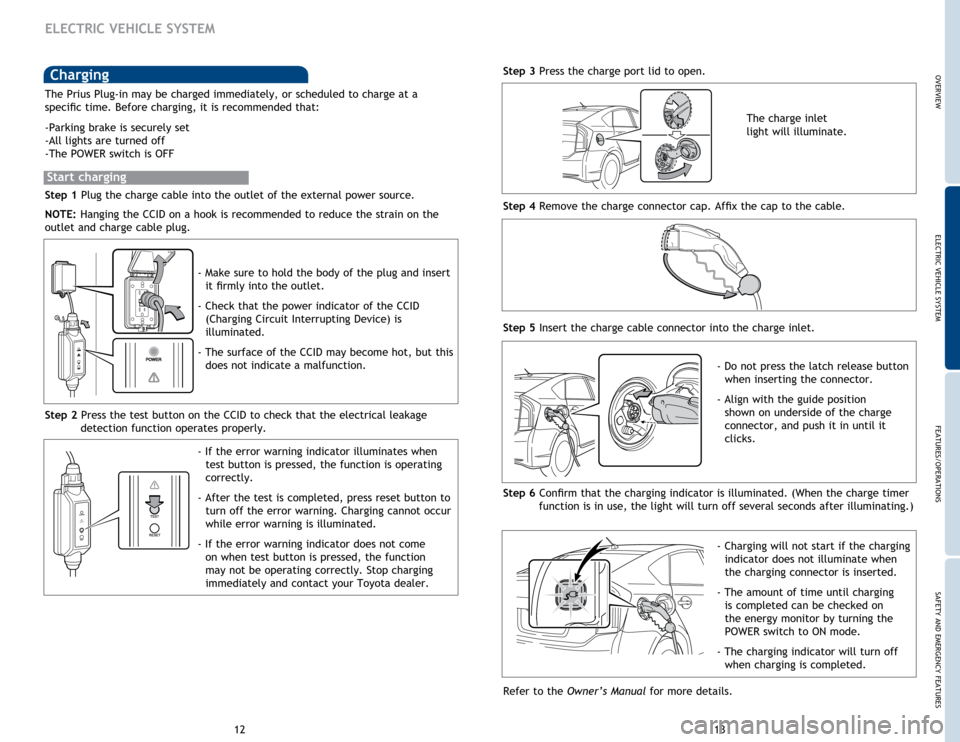
13
12
ELECTRIC VEHICLE SYSTEM
Charging
Step 1 Plug the charge cable into the outlet of the external power source.
NOTE: Hanging the CCID on a hook is recommended to reduce the strain on the
outlet and charge cable plug.
- Make sure to hold the body of the plug and insert
it firmly into the outlet.
- Check that the power indicator of the CCID (Charging Circuit Interrupting Device) is
illuminated.
- The surface of the CCID may become hot, but this does not indicate a malfunction.
Step 2 Press the test button on the CCID to check that the electrical leakage detection function operates properly.
- If the error warning indicator illuminates when test button is pressed, the function is operating
correctly.
- After the test is completed, press reset button to turn off the error warning. Charging cannot occur
while error warning is illuminated.
- If the error warning indicator does not come on when test button is pressed, the function
may not be operating correctly. Stop charging
immediately and contact your Toyota dealer. Step 3 Press the charge port lid to open.
Step 4 Remove the charge connector cap. Affix the cap to the cable.
The charge inlet
light will illuminate.
Step 5 Insert the charge cable connector into the charge inlet.
- Do not press the latch release button when inserting the connector.
- Align with the guide position shown on underside of the charge
connector, and push it in until it
clicks.
Step 6 Confirm that the charging indicator is illuminated. (When the charge timer function is in use, the light will turn off several seconds after illuminating.)
- Charging will not start if the charging indicator does not illuminate when
the charging connector is inserted.
- The amount of time until charging is completed can be checked on
the energy monitor by turning the
POWER switch to ON mode.
- The charging indicator will turn off when charging is completed.
The Prius Plug-in may be charged immediately, or scheduled to charge at a
specific time. Before charging, it is recommended that:
-Parking brake is securely set
-All lights are turned off
-The POWER switch is OFF
Start charging
Refer to the
Owner’s Manual for more details.
OVERVIEWELECTRIC VEHICLE SYSTEM FEATURES/OPERATIONS
SAFETY AND EMERGENCY FEATURES
Page 10 of 21
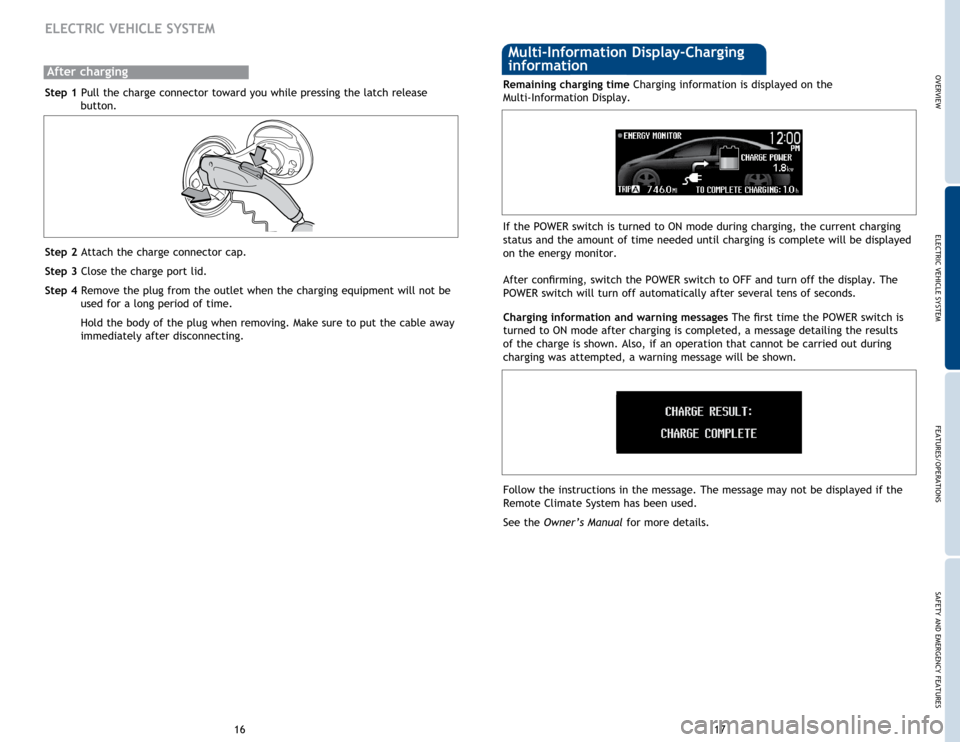
17
16
ELECTRIC VEHICLE SYSTEM
Step 1 Pull the charge connector toward you while pressing the latch release
button.
Step 2 Attach the charge connector cap.
Step 3 Close the charge port lid.
Step 4 Remove the plug from the outlet when the charging equipment will not be used for a long period of time.
Hold the
body of the plug when removing. Make sure to put the cable away
immediately after disconnecting.
After charging
Charging information and warning messages The first time the POWER switch is
turned to ON mode after charging is completed, a message detailing the results
of the charge is shown. Also, if an operation that cannot be carried out during
charging was attempted, a warning message will be shown. Remaining charging time Charging information is displayed on the
Multi-Information Display.
If the POWER switch is turned to ON mode during charging, the current charging
status and the amount of time needed until charging is complete will be displayed
on the energy monitor.
After confirming, switch the POWER switch to OFF and turn off the display. The
POWER switch will turn off automatically after several tens of seconds.
Multi-Information Display-Charging
information
Follow the instructions in the message. The message may not be displayed if the
Remote Climate System has been used.
See the Owner’s Manual for more details.
OVERVIEWELECTRIC VEHICLE SYSTEM FEATURES/OPERATIONS
SAFETY AND EMERGENCY FEATURES
Page 11 of 21
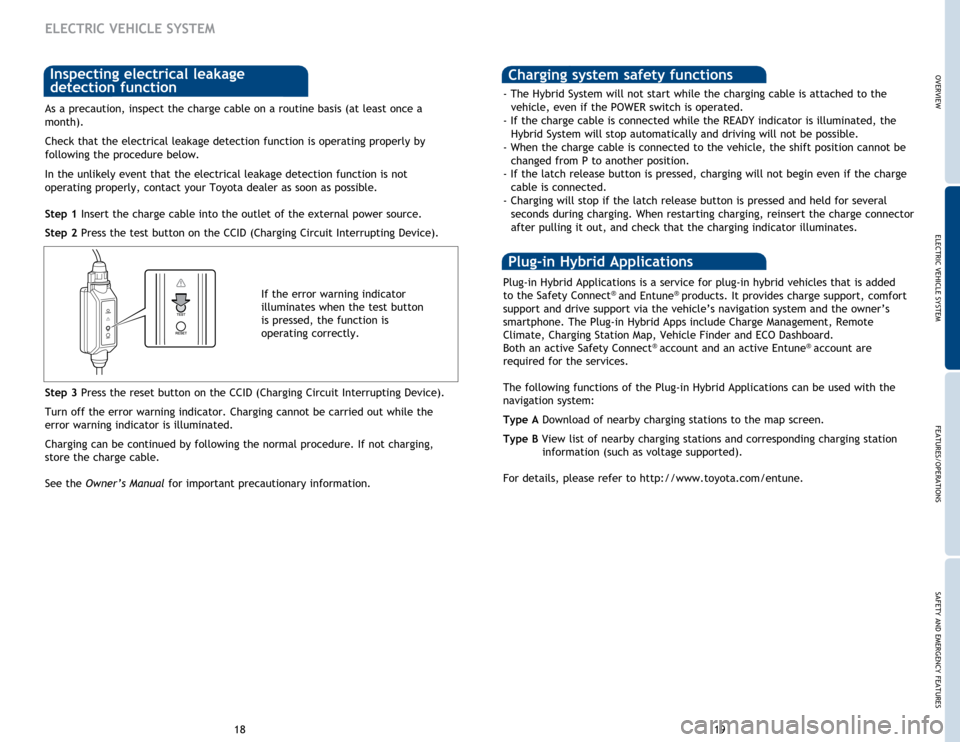
19
18
As a precaution, inspect the charge cable on a routine basis (at least once a
month).
Check that the electrical leakage detection function is operating properly by
following the procedure below.
In the unlikely event that the electrical leakage detection function is not
operating properly, contact your Toyota dealer as soon as possible.
Step 1 Insert the charge cable into the outlet of the external power source.
Step 2 Press the test button on the CCID (Charging Circuit Interrupting Device).
If the error warning indicator
illuminates when the test button
is pressed, the function is
operating correctly.
Step 3 Press the reset button on the CCID (Charging Circuit Interrupting Device).
Turn off the error warning indicator. Charging cannot be carried out while the
error warning indicator is illuminated.
Charging can be continued by following the normal procedure. If not charging,
store the charge cable.
See the Owner’s Manual for important precautionary information.
Inspecting electrical leakage
detection function
ELECTRIC VEHICLE SYSTEM
Charging system safety functions
- The Hybrid System will not start while the charging cable is attached to the
vehicle, even if the POWER switch is operated.
- If the charge cable is connected while the READY indicator is illuminated, the Hybrid System will stop automatically and driving will not be possible.
- When the charge cable is connected to the vehicle, the shift position cannot be changed from P to another position.
- If the latch release button is pressed, charging will not begin even if the charge cable is connected.
- Charging will stop if the latch release button is pressed and held for several seconds during charging. When restarting charging, reinsert the charge connector
after pulling it out, and check that the charging indicator illuminates.
Plug-in Hybrid Applications is a service for plug-in hybrid vehicles that is added
to the Safety Connect® and Entune® products. It provides charge support, comfort
support and drive support via the vehicle’s navigation system and the owner’s
smartphone. The Plug-in Hybrid Apps include Charge Management, Remote
Climate, Charging Station Map, Vehicle Finder and ECO Dashboard.
Both an active Safety Connect
® account and an active Entune® account are
required for the services.
The following functions of the Plug-in Hybrid Applications can be used with the
navigation system:
Type A Download of nearby charging stations to the map screen.
Type B View list of nearby charging stations and corresponding charging station information (such as voltage supported).
For details, please refer to http://www.toyota.com/entune.
Plug-in Hybrid Applications
OVERVIEWELECTRIC VEHICLE SYSTEM FEATURES/OPERATIONS
SAFETY AND EMERGENCY FEATURES
Page 18 of 21
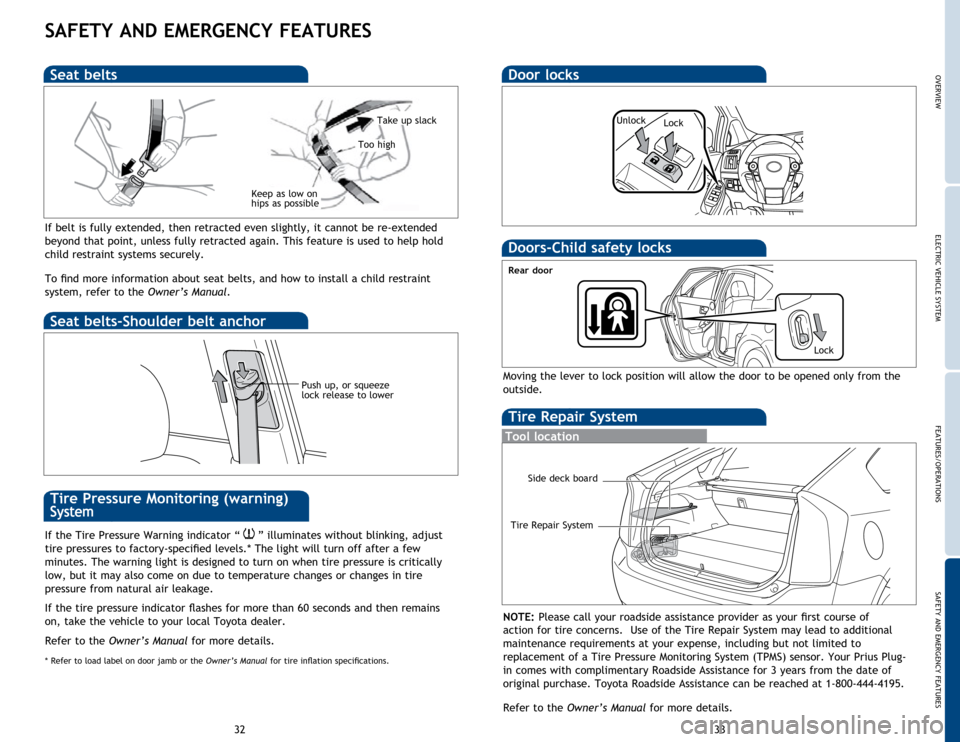
33
32
SAFETY AND EMERGENCY FEATURES
If belt is fully extended, then retracted even slightly, it cannot be re-extended
beyond that point, unless fully retracted again. This feature is used to help hold
child restraint systems securely.
To find more information about seat belts, and how to install a child restraint
system, refer to the Owner’s Manual.
Keep as low on
hips as possible
Take up slack
Too high
Seat belts
Push up, or squeeze
lock release to lower
Seat belts-Shoulder belt anchor
Door locks
If the Tire Pressure Warning indicator “” illuminates without blinking, adjust
tire pressures to factory-specified levels.* The light will turn off after a few
minutes. The warning light is designed to turn on when tire pressure is critically
low, but it may also come on due to temperature changes or changes in tire
pressure from natural air leakage.
If the tire pressure indicator flashes for more than 60 seconds and then remains
on, take the vehicle to your local Toyota dealer.
Refer to the Owner’s Manual for more details.
* Refer to load label on door jamb or the Owner’s Manual for tire inflation specifications.
Tire Pressure Monitoring (warning)
System
Tire Repair System
Tool location
NOTE: Please call your roadside assistance provider as your first course of
action for tire concerns. Use of the Tire Repair System may lead to additional
maintenance requirements at your expense, including but not limited to
replacement of a Tire Pressure Monitoring System (TPMS) sensor. Your Prius Plug-
in comes with complimentary Roadside Assistance for 3 years from the date of
original purchase. Toyota Roadside Assistance can be reached at 1-800-444-4195.
Refer to the Owner’s Manual for more details.
Tire Repair System
Moving the lever to lock position will allow the door to be opened only from the
outside.
Rear door
Doors-Child safety locks
Unlock
Side deck board Lock
Lock
OVERVIEWELECTRIC VEHICLE SYSTEM FEATURES/OPERATIONS
SAFETY AND EMERGENCY FEATURES